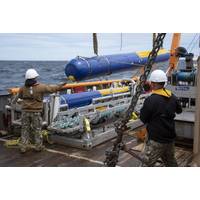
Subsea Defense: Navy Deepens Commitment to Underwater Vehicles
of the Navy’s Unmanned Systems (UxS) Roadmap was issued in 2018, and a new version is expected in the near future. The 2018 document states that UxS will operate in every domain; always be an option; and be at their best when teamed with Sailors and Marines“UxS will strengthen naval power at, on, and from the sea by reducing operational risk and cost. UxS operating in the air, on the surface, under the sea, and on shore as a rapidly adaptable and interconnected network will provide access to areas denied to manned platforms, provide better situational awareness, increase capabilities
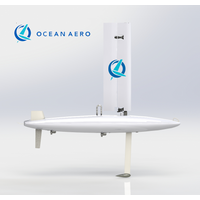
Ocean Aero to Supply Vehicles for Homeland Security
;T) for a research, evaluation and testing program.Ocean Aero will deliver a mix of its Navigator and Discovery models and working closely with DHS and other program participants—the U.S. Coast Guard (USCG), U.S. Customs and Border Protection (CBP), The University of Southern Mississippi, the U.S. Naval Research Laboratory (NRL), and Cherokee Nation Strategic Programs, LLC. Ocean Aero’s vehicles will be deployed in a wide range of ocean environments providing a platform for the integration, testing, and evaluation of a variety of advanced sensors.“This is a strategic agreement, and we&rsquo
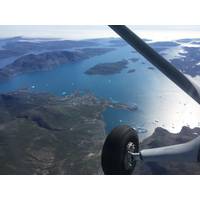
Airborne Hyperspectral Survey, Mineral Mapping in Greenland
of Mineral Resources. The first phase of the project consisted of collecting airborne and land-based data. Field operations were conducted from late July to early August 2019 by project partners including the Greenland Ministry of Mineral Resources, the U.S. Department of State, the U.S. Naval Research Laboratory, the U.S. Geological Survey, and Asiaq - Greenland Survey. The next phase of the project will include processing and analysis of the hyperspectral data. ASL's team of researchers, analysts and geologists will generate a range of information products and maps in collaboration
Navy Space-Based Orbital Debris Sensor Gets Patent
Small orbital debris objects can threaten vital space-based assets. The Navy's patented compact debris detection device can detect debris in near real-time and provide essential trajectory data for future use. The U.S. Naval Research Laboratory (NRL), Geospace Science and Technology Branch, received U.S. patent (#8976245), March 10, for the Optical Orbital Debris Spotter - a compact, low power, low cost, local space debris detection concept that can be integrated into larger satellite designs, or flown independently on-board nano-satellite platforms. Man-made debris orbiting the Earth continues to
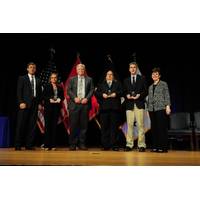
Awards Ceremony Recognizes NRL Researchers
Eighteen U.S. Naval Research Laboratory (NRL) scientists and engineers representing ten NRL research divisions were recognized with the prestigious Dr. Delores M. Etter Top Scientist and Engineer of the Year Award. The award ceremony was held on June 6th, with Assistant Secretary of the Navy (Research, Development & Acquisition) Sean Stackley, and Dr. Delores Etter presenting the awards. This annual award is sponsored by the Assistant Secretary of the Navy for Research, Development and Acquisition. Former Assistant Secretary of the Navy, Delores Etter established the awards in 2006 to recognize
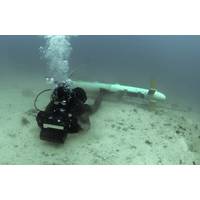
NRL Models Deepwater Horizon Oil Spill
NRL Shows Capability to Forecast Water Clarity During Naval Missions Dr. Jason Jolliff is an oceanographer with the U.S. Naval Research Laboratory (NRL). "The emphasis here," he says, "is on developing models of the ocean environment to help the naval warfighter." His most recent paper, published in Ocean Modeling (March 2014), shows NRL can also forecast where oil will go following a major spill. "If you're going to do forecasting," he says, "you have to get the ocean circulation correct. It's fundamental to all else." Jolliff plugged the distribution of
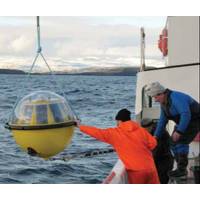
Navy's Global Ocean Forecast System Goes Public
The U.S. Naval Research Laboratory (NRL) & the National Center for Environmental Prediction (NCEP) within the National Ocean and Atmospheric Administration (NOAA) have entered into a formal agreement that results in NCEP using Navy developed global ocean forecast model technology to make environmental ocean forecasts for public use. “Development of an advanced global ocean prediction system has been a long-term Navy interest,” said Dr. Gregg Jacobs, head, NRL Ocean Dynamics and Prediction Branch. “This use of Navy developed systems for global ocean forecasting represents dual

Study: Electrical Properties of Topological Insulators
By Donna McKinney Scientists at the U.S. Naval Research Laboratory (NRL) have demonstrated for the first time that one can electrically access the remarkable properties predicted for a topological insulator (TI). They used a ferromagnetic metal/tunnel barrier contact as a voltage probe to detect the spin polarization created in the topologically protected surface states when an unpolarized bias current is applied. This accomplishment identifies a successful electrical approach that provides direct access to the TI surface state spin system, significantly advances our fundamental understanding of
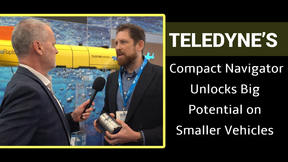
 February 2025
February 2025





